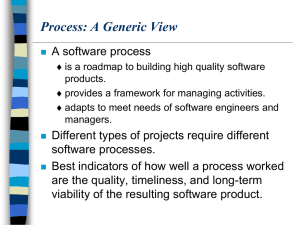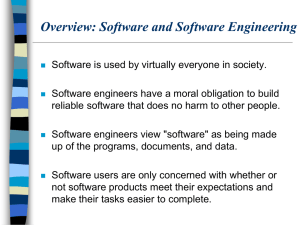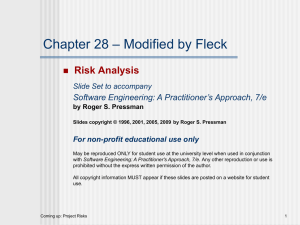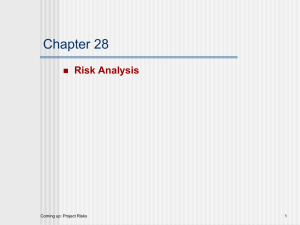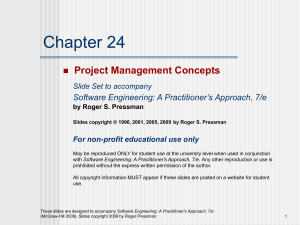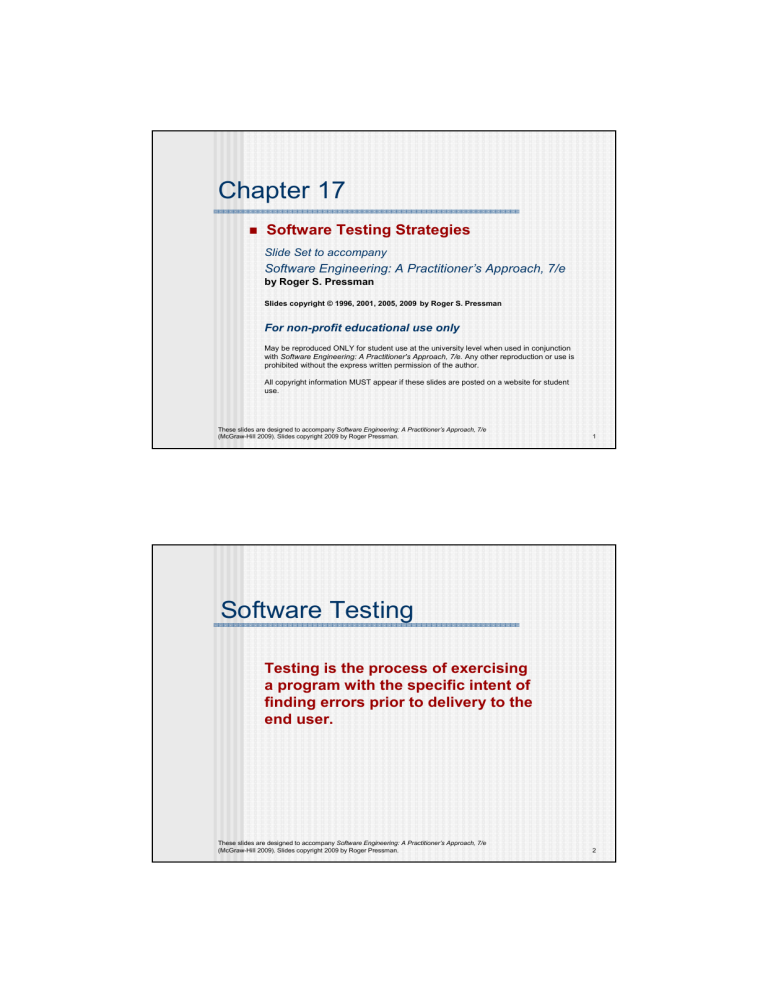
Chapter 17 Software Testing Strategies Slide Set to accompany Software Engineering: A Practitioner’s Approach, 7/e by Roger S. Pressman Slides copyright © 1996, 2001, 2005, 2009 by Roger S. Pressman For non-profit educational use only May be reproduced ONLY for student use at the university level when used in conjunction with Software Engineering: A Practitioner's Approach, 7/e. Any other reproduction or use is prohibited without the express written permission of the author. All copyright information MUST appear if these slides are posted on a website for student use. These slides are designed to accompany Software Engineering: A Practitioner’s Approach, 7/e (McGraw-Hill 2009). Slides copyright 2009 by Roger Pressman. 1 Software Testing Testing is the process of exercising a program with the specific intent of finding errors prior to delivery to the end user. These slides are designed to accompany Software Engineering: A Practitioner’s Approach, 7/e (McGraw-Hill 2009). Slides copyright 2009 by Roger Pressman. 2 What Testing Shows errors requirements conformance performance an indication of quality These slides are designed to accompany Software Engineering: A Practitioner’s Approach, 7/e (McGraw-Hill 2009). Slides copyright 2009 by Roger Pressman. 3 Strategic Approach To perform effective testing, you should conduct effective technical reviews. By doing this, many errors will be eliminated before testing commences. Testing begins at the component level and works "outward" toward the integration of the entire computerbased system. Different testing techniques are appropriate for different software engineering approaches and at different points in time. Testing is conducted by the developer of the software and (for large projects) an independent test group. Testing and debugging are different activities, but debugging must be accommodated in any testing strategy. These slides are designed to accompany Software Engineering: A Practitioner’s Approach, 7/e (McGraw-Hill 2009). Slides copyright 2009 by Roger Pressman. 4 V&V Verification refers to the set of tasks that ensure that software correctly implements a specific function. Validation refers to a different set of tasks that ensure that the software that has been built is traceable to customer requirements. Boehm [Boe81] states this another way: Verification: "Are we building the product right?" Validation: "Are we building the right product?" These slides are designed to accompany Software Engineering: A Practitioner’s Approach, 7/e (McGraw-Hill 2009). Slides copyright 2009 by Roger Pressman. 5 Who Tests the Software? developer Understands the system but, will test "gently" and, is driven by "delivery" independent tester Must learn about the system, but, will attempt to break it and, is driven by quality These slides are designed to accompany Software Engineering: A Practitioner’s Approach, 7/e (McGraw-Hill 2009). Slides copyright 2009 by Roger Pressman. 6 Testing Strategy System engineering Analysis modeling Design modeling Code generation Unit test Integration test Validation test System test These slides are designed to accompany Software Engineering: A Practitioner’s Approach, 7/e (McGraw-Hill 2009). Slides copyright 2009 by Roger Pressman. 7 Testing Strategy We begin by ‘testing-in-the-small’ and move toward ‘testing-in-the-large’ For conventional software The module (component) is our initial focus Integration of modules follows For OO software our focus when “testing in the small” changes from an individual module (the conventional view) to an OO class that encompasses attributes and operations and implies communication and collaboration These slides are designed to accompany Software Engineering: A Practitioner’s Approach, 7/e (McGraw-Hill 2009). Slides copyright 2009 by Roger Pressman. 8 Strategic Issues Specify product requirements in a quantifiable manner long before testing commences. State testing objectives explicitly. Understand the users of the software and develop a profile for each user category. Develop a testing plan that emphasizes “rapid cycle testing.” Build “robust” software that is designed to test itself Use effective technical reviews as a filter prior to testing Conduct technical reviews to assess the test strategy and test cases themselves. Develop a continuous improvement approach for the testing process. These slides are designed to accompany Software Engineering: A Practitioner’s Approach, 7/e (McGraw-Hill 2009). Slides copyright 2009 by Roger Pressman. 9 Unit Testing module to be tested results software engineer test cases These slides are designed to accompany Software Engineering: A Practitioner’s Approach, 7/e (McGraw-Hill 2009). Slides copyright 2009 by Roger Pressman. 10 Unit Testing module to be tested interface local data structures boundary conditions independent paths error handling paths test cases These slides are designed to accompany Software Engineering: A Practitioner’s Approach, 7/e (McGraw-Hill 2009). Slides copyright 2009 by Roger Pressman. 11 Unit Test Environment driver interface local data structures Module boundary conditions independent paths error handling paths stub stub test cases RESULTS These slides are designed to accompany Software Engineering: A Practitioner’s Approach, 7/e (McGraw-Hill 2009). Slides copyright 2009 by Roger Pressman. 12 Integration Testing Strategies Options: • the “big bang” bang” approach • an incremental construction strategy These slides are designed to accompany Software Engineering: A Practitioner’s Approach, 7/e (McGraw-Hill 2009). Slides copyright 2009 by Roger Pressman. 13 Top Down Integration A B F top module is tested with stubs G stubs are replaced one at a time, "depth first" C as new modules are integrated, some subset of tests is rere-run D E These slides are designed to accompany Software Engineering: A Practitioner’s Approach, 7/e (McGraw-Hill 2009). Slides copyright 2009 by Roger Pressman. 14 Bottom-Up Integration A B F G drivers are replaced one at a time, "depth first" C worker modules are grouped into builds and integrated D E cluster These slides are designed to accompany Software Engineering: A Practitioner’s Approach, 7/e (McGraw-Hill 2009). Slides copyright 2009 by Roger Pressman. 15 Sandwich Testing A B F Top modules are tested with stubs G C Worker modules are grouped into builds and integrated D E cluster These slides are designed to accompany Software Engineering: A Practitioner’s Approach, 7/e (McGraw-Hill 2009). Slides copyright 2009 by Roger Pressman. 16 Regression Testing Regression testing is the re-execution of some subset of tests that have already been conducted to ensure that changes have not propagated unintended side effects Whenever software is corrected, some aspect of the software configuration (the program, its documentation, or the data that support it) is changed. Regression testing helps to ensure that changes (due to testing or for other reasons) do not introduce unintended behavior or additional errors. Regression testing may be conducted manually, by reexecuting a subset of all test cases or using automated capture/playback tools. These slides are designed to accompany Software Engineering: A Practitioner’s Approach, 7/e (McGraw-Hill 2009). Slides copyright 2009 by Roger Pressman. 17 Smoke Testing A common approach for creating “daily builds” for product software Smoke testing steps: Software components that have been translated into code are integrated into a “build.” • A build includes all data files, libraries, reusable modules, and engineered components that are required to implement one or more product functions. A series of tests is designed to expose errors that will keep the build from properly performing its function. • The intent should be to uncover “show stopper” errors that have the highest likelihood of throwing the software project behind schedule. The build is integrated with other builds and the entire product (in its current form) is smoke tested daily. • The integration approach may be top down or bottom up. These slides are designed to accompany Software Engineering: A Practitioner’s Approach, 7/e (McGraw-Hill 2009). Slides copyright 2009 by Roger Pressman. 18 Object-Oriented Testing begins by evaluating the correctness and consistency of the analysis and design models testing strategy changes the concept of the ‘unit’ broadens due to encapsulation integration focuses on classes and their execution across a ‘thread’ or in the context of a usage scenario validation uses conventional black box methods test case design draws on conventional methods, but also encompasses special features These slides are designed to accompany Software Engineering: A Practitioner’s Approach, 7/e (McGraw-Hill 2009). Slides copyright 2009 by Roger Pressman. 19 Broadening the View of “Testing” It can be argued that the review of OO analysis and design models is especially useful because the same semantic constructs (e.g., classes, attributes, operations, messages) appear at the analysis, design, and code level. Therefore, a problem in the definition of class attributes that is uncovered during analysis will circumvent side effects that might occur if the problem were not discovered until design or code (or even the next iteration of analysis). These slides are designed to accompany Software Engineering: A Practitioner’s Approach, 7/e (McGraw-Hill 2009). Slides copyright 2009 by Roger Pressman. 20 OO Testing Strategy class testing is the equivalent of unit testing operations within the class are tested the state behavior of the class is examined integration applied three different strategies thread-based testing—integrates the set of classes required to respond to one input or event use-based testing—integrates the set of classes required to respond to one use case cluster testing—integrates the set of classes required to demonstrate one collaboration These slides are designed to accompany Software Engineering: A Practitioner’s Approach, 7/e (McGraw-Hill 2009). Slides copyright 2009 by Roger Pressman. 21 WebApp Testing - I The content model for the WebApp is reviewed to uncover errors. The interface model is reviewed to ensure that all use cases can be accommodated. The design model for the WebApp is reviewed to uncover navigation errors. The user interface is tested to uncover errors in presentation and/or navigation mechanics. Each functional component is unit tested. These slides are designed to accompany Software Engineering: A Practitioner’s Approach, 7/e (McGraw-Hill 2009). Slides copyright 2009 by Roger Pressman. 22 WebApp Testing - II Navigation throughout the architecture is tested. The WebApp is implemented in a variety of different environmental configurations and is tested for compatibility with each configuration. Security tests are conducted in an attempt to exploit vulnerabilities in the WebApp or within its environment. Performance tests are conducted. The WebApp is tested by a controlled and monitored population of end-users. The results of their interaction with the system are evaluated for content and navigation errors, usability concerns, compatibility concerns, and WebApp reliability and performance. These slides are designed to accompany Software Engineering: A Practitioner’s Approach, 7/e (McGraw-Hill 2009). Slides copyright 2009 by Roger Pressman. 23 High Order Testing Validation testing System testing Alpha/Beta testing Recovery testing Focus is on software requirements Focus is on system integration Focus is on customer usage forces the software to fail in a variety of ways and verifies that recovery is properly performed Security testing verifies that protection mechanisms built into a system will, in fact, protect it from improper penetration Stress testing Performance Testing executes a system in a manner that demands resources in abnormal quantity, frequency, or volume test the run-time performance of software within the context of an integrated system These slides are designed to accompany Software Engineering: A Practitioner’s Approach, 7/e (McGraw-Hill 2009). Slides copyright 2009 by Roger Pressman. 24 Debugging: A Diagnostic Process These slides are designed to accompany Software Engineering: A Practitioner’s Approach, 7/e (McGraw-Hill 2009). Slides copyright 2009 by Roger Pressman. 25 The Debugging Process These slides are designed to accompany Software Engineering: A Practitioner’s Approach, 7/e (McGraw-Hill 2009). Slides copyright 2009 by Roger Pressman. 26 Debugging Effort time required to correct the error and conduct regression tests time required to diagnose the symptom and determine the cause These slides are designed to accompany Software Engineering: A Practitioner’s Approach, 7/e (McGraw-Hill 2009). Slides copyright 2009 by Roger Pressman. 27 Symptoms & Causes symptom and cause may be geographically separated symptom may disappear when another problem is fixed cause may be due to a combination of nonnon-errors cause may be due to a system or compiler error symptom cause cause may be due to assumptions that everyone believes symptom may be intermittent These slides are designed to accompany Software Engineering: A Practitioner’s Approach, 7/e (McGraw-Hill 2009). Slides copyright 2009 by Roger Pressman. 28 Consequences of Bugs infectious damage catastrophic extreme serious disturbing mild annoying Bug Type Bug Categories: functionfunction-related bugs, systemsystem-related bugs, data bugs, coding bugs, design bugs, documentation bugs, standards violations, etc. These slides are designed to accompany Software Engineering: A Practitioner’s Approach, 7/e (McGraw-Hill 2009). Slides copyright 2009 by Roger Pressman. 29 Debugging Techniques brute force / testing backtracking induction deduction These slides are designed to accompany Software Engineering: A Practitioner’s Approach, 7/e (McGraw-Hill 2009). Slides copyright 2009 by Roger Pressman. 30 Correcting the Error Is the cause of the bug reproduced in another part of the program? In many situations, a program defect is caused by an erroneous pattern of logic that may be reproduced elsewhere. What "next bug" might be introduced by the fix I'm about to make? Before the correction is made, the source code (or, better, the design) should be evaluated to assess coupling of logic and data structures. What could we have done to prevent this bug in the first place? This question is the first step toward establishing a statistical software quality assurance approach. If you correct the process as well as the product, the bug will be removed from the current program and may be eliminated from all future programs. These slides are designed to accompany Software Engineering: A Practitioner’s Approach, 7/e (McGraw-Hill 2009). Slides copyright 2009 by Roger Pressman. 31 Final Thoughts Think -- before you act to correct Use tools to gain additional insight If you’re at an impasse, get help from someone else Once you correct the bug, use regression testing to uncover any side effects These slides are designed to accompany Software Engineering: A Practitioner’s Approach, 7/e (McGraw-Hill 2009). Slides copyright 2009 by Roger Pressman. 32
